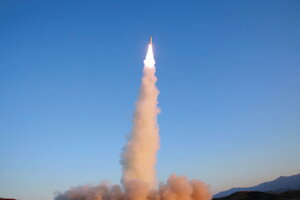Why North Korea may present Trump's toughest international issue
The Trump team has few appealing options for dealing with North Korea, which launched a ballistic missile test Sunday. The newly tested missile can be more easily hidden from US surveillance.

In this Sunday, Feb. 12, 2017, photo distributed on Monday, Feb. 13, 2017, by the North Korean government, "Pukguksong-2” is launched at an undisclosed location in North Korea. Independent journalists were not given access to cover the event depicted in this image distributed by the Korean Central News Agency via Korea News Service. The "Pukguksong-2" the North's Korean Central News Agency said was a "Korean style new type strategic weapon system."
Korean Central News Agency/Korea News Service via AP
North Korea’s Sunday missile test may have been an important step toward developing an intercontinental ballistic missile (ICBM) that could threaten the United States. It was also a reminder that Pyongyang’s nuclear ambitions may be the new Trump administration’s single most difficult foreign-policy challenge.
So far President Trump has reacted with restraint. He hasn’t tweeted out a slam of North Korean leader Kim Jong-un or repeated his past vow that a North Korean ICBM “won’t happen.” Mr. Trump’s initial response, instead, was to simply stand next to visiting Japanese premier Shinzo Abe and vow support for Tokyo in the face of North Korea’s aggressive weapon testing.
The Trump team may find it has few appealing options as it weighs a response to the missile launch. Sanctions have already choked the North Korean economy. Shows of force don’t seem to deter North Korea’s leadership. Meanwhile, the clock keeps ticking on a problem that has bedeviled all recent US chief executives.
“It’s a big deal,” says Thomas Karako, a senior fellow in the International Security Program at the Center for Strategic and International Security, referring to Sunday’s test. “It remains to be seen how big in the immediate term.”
Switch to solid-fuel missiles
The importance of Sunday’s test does not lie in the performance of the North Korean missile per se. It flew only 300 miles or so before splashing down in international waters.
It stems instead from the missile’s apparent use of solid-fuel technology. North Korean state media on Monday boasted that that weekend test had used a solid-fuel engine derived from an existing submarine-launched missile, and released a video that seemed to document the claim.
South Korea’s military has issued a statement saying that the missile “appears” to use solid fuel. US experts concur, saying among other things that the trajectory appeared to match a prior launch of the KN-11 submarine-launched missile.
Solid-fuel missiles can be launched much more quickly than liquid counterparts and require fewer support vehicles. That makes them more difficult for overhead surveillance – read “US spy satellites” – to spot. In addition they are more reliable.
“North Korea is switching over to solid-fueled missiles, which are far more threatening than liquid-fueled Scuds, Nodongs and Musudans,” tweeted Jeffrey Lewis, director of the East Asia Nonproliferation Program at the Middlebury Institute of International Studies at Monterey, on Sunday.
Currently North Korean missiles could hit South Korea and Japan. Some experts think the medium-range Musudan, at the upper end of its range, could reach US military forces on the island of Guam.
At the moment that’s the limit of Pyongyang’s reach. But stacking solid-fuel motors could be North Korea’s easiest path to a true ICBM that could hold the US itself at risk.
“They could well be testing the constituent parts of a longer-range missile,” says Dr. Karako of CSIS.
US “strategic patience” with regard to North Korea has now failed, according to Karako. He says that means the US should push ahead with plans to deploy a US missile-defense system known as THAAD in South Korea, despite objections from China.
It could also mean the US needs to further develop the military ability to strike at North Korean launchers and command and control sites in the event of a failure of deterrence.
Trump's options
Trump officials have vowed to be more assertive in their policies toward North Korea than their Obama-era counterparts. But it’s not clear exactly what that means.
It’s likely the administration will look at ways to further tighten financial controls, for instance. But North Korea is virtually shut off from the world economy already.
It is possible Trump might opt for secondary sanctions that would target Chinese banks and firms that do business with North Korea. Trump has long said he would push China, North Korea’s only friend, to do more to curb North Korean nuclear and missile programs.
But Beijing might be reluctant to go along, given Trump’s insistence that China cheats the US on trade, steals US jobs, and manipulates its currency. It is hard to envision China cooperating in this area if Trump imposes stiff tariffs on Chinese goods entering the US, as he has threatened to do.
Indeed, a Chinese Communist Party newspaper on Monday said that it is futile for the US to continue its sanctions and other measures against North Korea without acknowledging North Korea’s own security concerns.
“The military threat it faces looks very real,” said the Global Times newspaper, according to an Associated Press report. South Korea's military is backed up by some 28,000 US troops stationed in the country.
Meanwhile, the US, Japan, and South Korea requested that the UN Security Council meet to discuss the matter. Closed-door talks were set for Monday afternoon.
UN Secretary-General Antonio Guterres strongly condemned North Korea’s latest ballistic missile test and called it a “troubling violation” of existing sanctions.
“The secretary-general appeals to the international community to continue to address this situation in a united manner,” said UN spokesman Farhan Haq.

